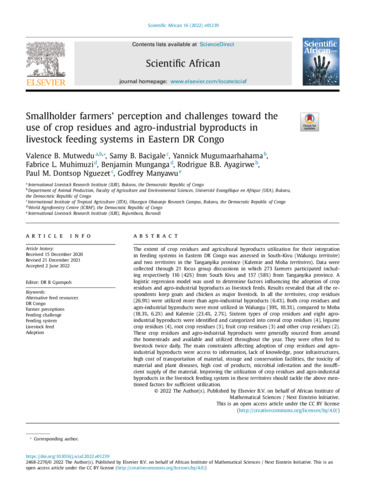Smallholder farmers' perception and challenges toward the use of crop residues and agro-industrial byproducts in livestock feeding systems in eastern DR Congo
Abstract
The extent of crop residues and agricultural byproducts utilization for their integration in feeding systems in Eastern DR Congo was assessed in South-Kivu (Walungu territoire) and two territoires in the Tanganyika province (Kalemie and Moba territoires). Data were collected through 21 focus group discussions in which 273 farmers participated including respectively 116 (42%) from South Kivu and 157 (58%) from Tanganyika province. A logistic regression model was used to determine factors influencing the adoption of crop residues and agro-industrial byproducts as livestock feeds. Results revealed that all the respondents keep goats and chicken as major livestock. In all the territoires, crop residues (26.9%) were utilized more than agro-industrial byproducts (6.4%). Both crop residues and agro-industrial byproducts were most utilized in Walungu (39%, 10.3%), compared to Moba (18.3%, 6.2%) and Kalemie (23.4%, 2.7%). Sixteen types of crop residues and eight agro-industrial byproducts were identified and categorized into cereal crop residues (4), legume crop residues (4), root crop residues (3), fruit crop residues (3) and other crop residues (2). These crop residues and agro-industrial byproducts were generally sourced from around the homesteads and available and utilized throughout the year. They were often fed to livestock twice daily. The main constraints affecting adoption of crop residues and agro-industrial byproducts were access to information, lack of knowledge, poor infrastructures, high cost of transportation of material, storage and conservation facilities, the toxicity of material and plant diseases, high cost of products, microbial infestation and the insufficient supply of the material. Improving the utilization of crop residues and agro-industrial byproducts in the livestock feeding system in these territoires should tackle the above mentioned factors for sufficient utilization.

